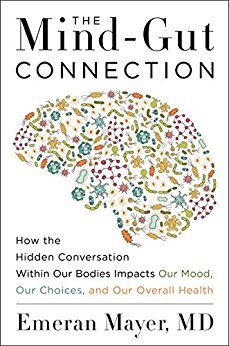More on this book
Community
Kindle Notes & Highlights
by
Emeran Mayer
Read between
March 13 - April 16, 2017
In this book, I will offer a revolutionary new look at how the brain, the gut, and the trillions of microorganisms living in the gut communicate with each other.
But while the World Health Organization, in a landmark report published in 2000, ranked the U.S. health care system as the highest in cost, it ranked it a disappointing 37th in overall performance, and 72nd by overall level of health among 191 member nations included in the study.
For decades, our understanding of the digestive system was based on the machine model of the entire body.
But as it turns out, this model is overly simplistic.
medicine continues to view the digestive system as being largely independent of the brain,
we now know that these two organs are intricately connected with each other, an insight re...
This highlight has been truncated due to consecutive passage length restrictions.
gut-brain...
This highlight has been truncated due to consecutive passage length restrictions.
the gut can influence our basic emotions, our pain sensitivity, and our social interactions, and even guide many of our decisions—and not just those about our food preferences and meal sizes.
The connection is hardwired in the form of anatomical connections between the brain and the gut, and facilitated by biological communication signals carried throughout the bloodstream.
Your gut has
its own nervous system,
k...
This highlight has been truncated due to consecutive passage length restrictions.
as the enteric nervous syst...
This highlight has been truncated due to consecutive passage length restrictions.
“second b...
This highlight has been truncated due to consecutive passage length restrictions.
The immune cells residing in your gut make up the largest component of your body’s immune system;
there
are more immune cells living in the wall of your gut than circulating in the blood or res...
This highlight has been truncated due to consecutive passage length restrictions.
The lining of your gut is studded with a huge number of endocrine cells, specialized cells that contain up to twenty different types of hormones that can be released into the bloodstream if called upon.
If you could clump all these endocrine cells together into one mass, it would be greater than all your other endocrine organs—your
The gut is also the largest storage facility for serotonin in our body.
Serotonin
plays a crucial role in such vital functions as sleep, appetite, pain sensitivity, mood, and overall well-being.
The gut is connected to the brain through thick nerve cables that can transfer information in both directions and through communication channels that use the bloodstream: hormones and inflammatory signaling molecules produced by the gut signaling up to the brain, and hormones produced by the brain signaling down to the various cells in the gut, such as the smooth muscle, the nerves, and the immune cells, changing their functions.
Gut feelings are stored in vast databases in the brain,
What we sense in our gut will ultimately affect not only the decisions we make about what to eat and drink, but also the people we choose to spend time with and the way we assess critical information as workers, jury members, and leaders.
view our gut feelings as the yin,
gut reactions as the yang.
Human Microbiome Project
was designed to understand the microbial components of our genetic and metabolic landscape, and how they contribute to our normal physiology and disease predisposition.
neurodevelopmental disorders such as autism and anxiety,
while the late period of low diversity coincides with the development of neurodegenerative disorders such as Parkinson’s and Alzheimer’s disease.
More than 100 trillion microbes live in the dark and nearly oxygen-free world of the human gut—about
This means that only 10 percent of the cells in or on a human being are actually human.
According to the new science of the microbiome, we humans are truly supraorganisms, composed of closely interconnected human and microbial components, which are inseparable and dependent on each other for survival.
As the microbial component is so closely connected through a shared biological communication system to all the other microbiomes in the soil, the air, the oceans, and the microbes living in symbiosis with almost all other living creatures, we are closely and inextricably tied into the earth’s web of life.
The microbes not only inhabit the inside of your gut; many of them sit on a razor-thin layer of mucus and cells that coats the inner lining of your intestine.
your gut microbes are in a prime position to influence your emotions, by generating and modulating signals the gut sends back to the brain. Thus, what starts as an emotion in the brain influences your gut and the signals generated by your microbes, and these signals in turn communicate back to the brain, reinforcing and sometimes even prolonging the emotional state.
There has been a dramatic, continuous increase in the reported prevalence of autism spectrum disorders,
from 4.5 in 10,000 children in 1966
1 in 68 children aged 8 yea...
This highlight has been truncated due to consecutive passage length restrictions.
the current prevalence to be 1 in 58 U.S. children.
suggested a common underlying mechanism related to a change in our gut microbiota during the last fifty years.
Changes in our lifestyles, diet, and in the widespread use of antibiotics have been implicated as possible causes.
Gut microbiota have also been linked to depression, which is the second leading cause of disability in the United States.
95 percent of the body’s serotonin is actually contained in specialized cells in the gut, and these
serotonin-containing cells are influenced by what we eat, by chemicals released from certain species of gut microbes, and by signals that the brain sends to them, informing them about our emotional state.
patients suffering from
abnormal gut reactions
reflect their emotion...
This highlight has been truncated due to consecutive passage length restrictions.
cyclical vomiting syndrome.


